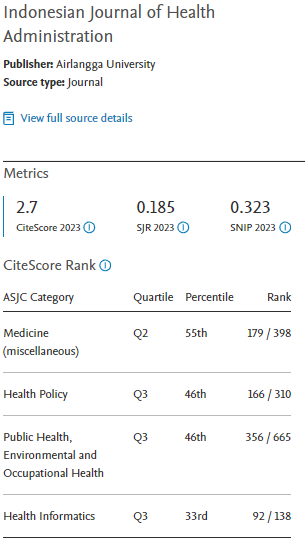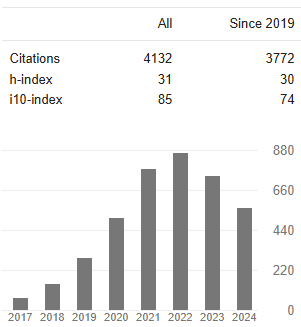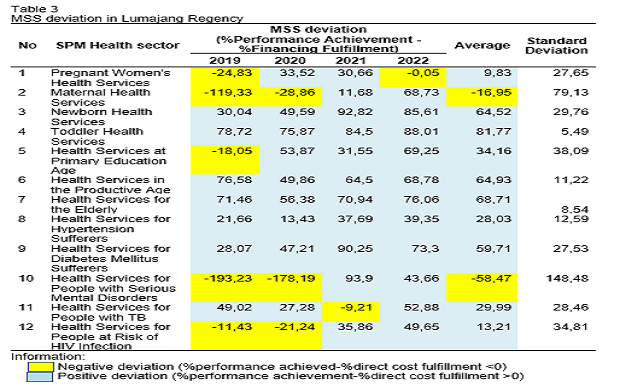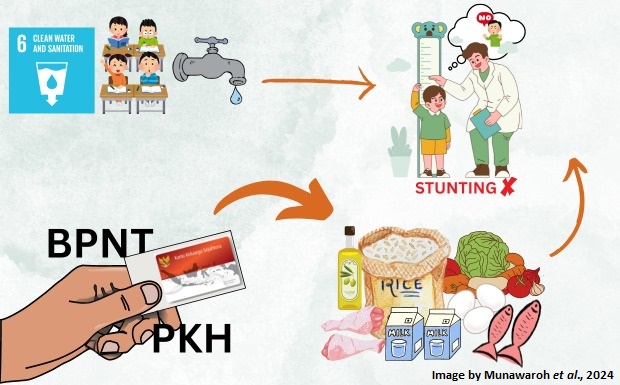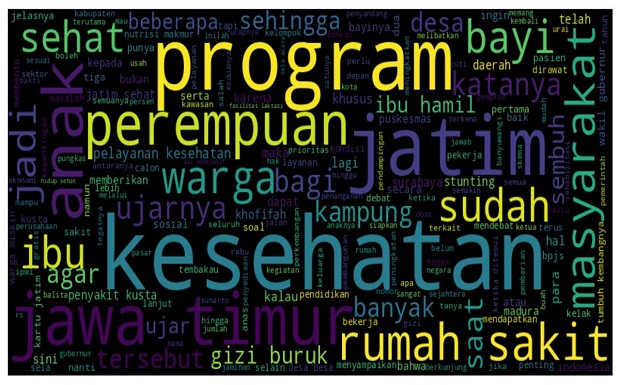THE ROLE OF PRENATAL CLASSES IN EXCLUSIVE BREASTFEEDING: EVIDENCE FROM PAPUA, INDONESIA
Downloads
Background: Exclusive breastfeeding (EBF) is a lifesaving practice for infants in vulnerable conditions. Therefore, it is crucial to ensure the optimization of EBF coverage in disadvantaged areas. One of the barriers to EBF is limited maternal knowledge, and prenatal classes are designed to improve maternal health knowledge and practices.
Aims: The study aimed to analyze the role of prenatal classes in supporting EBF in Papua.
Methods: The cross-sectional study examined 640 mothers with children aged 0-5 months from the Papua Region. Prenatal classes were an exposure variable, while EBF practice served as an outcome variable. Nine control variables, including age, marital status, education, work, wealth, sex, infant age, and early initiation of breastfeeding (EIBF), were incorporated into the analysis. Binary logistic regression test was used for analysis.
Results: The proportion of EBF in Papua is 50.7%. Mothers who participated in prenatal classes were 1.560 times more likely to practice EBF than those who did not (AOR = 1.560; 95% CI [1.476-1.649]). Additionally, the study identified nine control variables related to EBF in the Papua Region: type of residence, maternal age group, maternal marital status, education level, employment status, wealth status, infant age, infant sex, and EIBF.
Conclusion: Participation in prenatal classes is positively associated with the achievement of EBF practice in the Papua Region. Additional characteristics associated with a higher likelihood of EBF among Papuan mothers included having a higher level of education and employment, living in rural regions, experiencing poverty, being married, and achieving successful EIBF.
Keywords: exclusive breastfeeding, Papua, prenatal classes, public health, public health nutrition
Agho, K.E. et al. (2021) ‘Breastfeeding practices among adolescent mothers and associated factors in Bangladesh (2004–2014)’, Nutrients, 13(2), pp. 1–23. Available at: https://doi.org/10.3390/nu13020557.
Ahmadinezhad, G.S. et al. (2024) ‘Association between postpartum depression and breastfeeding self-efficacy in mothers: a systematic review and meta-analysis’, BMC Pregnancy and Childbirth, 24(1), p. 273. Available at: https://doi.org/10.1186/s12884-024-06465-4.
Alayón, S. et al. (2022) ‘Exclusive breastfeeding: Measurement to match the global recommendation’, Maternal and Child Nutrition, 18(4). Available at: https://doi.org/10.1111/mcn.13409.
Alijanzadeh, M., Asefzadeh, S. and Moosaniaye Zare, S.A. (2016) ‘Correlation between human development index and infant mortality rate worldwide’, Biotechnology and Health Sciences, 3(1), p. e35330. Available at: https://doi.org/10.17795/bhs-35330.
Ariful Islam, M. et al. (2019) ‘Prevalence and factors associated with early initiation of breastfeeding among Bangladeshi mothers: A nationwide cross-sectional study’, PLoS ONE, 14(4), pp. 1–13. Available at: https://doi.org/10.1371/journal.pone.0215733.
Ashar, H. et al. (2019) ‘Relationship between antenatal care and pregnancy classes with selection of place and birth attendant in Indonesia’, JKKI, 10(3), pp. 271–280. Available at: https://doi.org/10.20885/JKKI.Vol10.Iss3.art10.
Aurellia, D.S. et al. (2022) ‘Literature Review: Exclusive breastfeeding description in Indonesia from social cultural aspects’, in Proceedings of the International Conference on Sports Science and Health (ICSSH 2022). Atlantis Press International BV, pp. 121–142. Available at: https://doi.org/10.2991/978-94-6463-072-5_12.
Azhali, B.A., Setiabudi, D. and Alam, A. (2023) ‘Evaluating the impact of triple elimination program for mother-to-child transmission of HIV, syphilis, and hepatitis B in Indonesia’, Narra J, 3(3), p. e405. Available at: https://doi.org/10.52225/narra.v3i3.405.
Azhar, K. et al. (2020) ‘The influence of pregnancy classes on the use of maternal health services in Indonesia’, BMC Public Health, 20(1), pp. 1–9. Available at: https://doi.org/10.1186/s12889-020-08492-0.
Badan Pusat Statistik (2023) Human development index 2022. Jakarta: Badan Pusat Statistik.
Badan Pusat Statistik Provinsi Papua (2024) Indeks Pembangunan Manusia Provinsi Papua 2023. BPS Provinsi Papua.
Badan Pusat Statistik Provinsi Papua (2025) Indeks Pembangunan Manusia Provinsi Papua 2024. Badan Pusat Statistik Provinsi Papua.
Bankole, T.O., Solanke, B.L. and Bisiriyu, L.A. (2022) ‘What Are the Individual, Household, and Community Factors Associated With Optimal Breastfeeding Practices in Three Selected West African Countries?’, Journal of Population and Social Studies, 30, pp. 797–815. Available at: https://doi.org/10.25133/JPSSv302022.044.
Belvedere, L.M. et al. (2018) ‘Barriers to Optimal Breastfeeding in Rural Indonesia’, Archives of Epidemiology, 2018(03), pp. 1–7. Available at: https://doi.org/10.29011/2577-2252.
Caraka, R.E. et al. (2024) ‘Understanding pediatric health trends in Papua: Insights from SUSENAS, RISKESDAS, remote sensing, and its relevance to Prabowo and Gibran’s free lunch and milk program’, IEEE Access, 12, pp. 51536–51555. Available at: https://doi.org/10.1109/ACCESS.2024.3380018.
Denny, H.M. et al. (2022) ‘The determinants of four or more antenatal care visits among working women in Indonesia’, Asia-Pacific Journal of Public Health, 34(1), pp. 51–56. Available at: https://doi.org/10.1177/10105395211051237.
Dharmaraj, A., Ghimire, A. and Chinnaiyan, S. (2024) ‘Effect of exclusive breastfeeding practices on childhood morbidity among primiparous mothers in India: Analysis from National Family Health Survey-4, India during 2015-16’, Journal of Neonatal Nursing, 30(5), pp. 439–443. Available at: https://doi.org/10.1016/j.jnn.2023.10.004.
Directorate General of Nutrition Development and Maternal Child Health (2015) Performance Report of the Directorate General of Nutrition Development and KIA 2015. Jakarta: Ministry of Health.
Felipe-Dimog, E.B., Dumalhin, Y.J.B. and Liang, F.-W. (2023) ‘Factors of early breastfeeding initiation among Filipino women: A population-based cross-sectional study’, Applied Nursing Research, 74, p. 151732. Available at: https://doi.org/10.1016/j.apnr.2023.151732.
Fuada, N. and Setyawati, B. (2016) ‘Implementation of the pregnant women class in Indonesia’, Jurnal Kesehatan Reproduksi, 6(2), pp. 67–75. Available at: https://doi.org/10.22435/kespro.v6i2.5411.67-75.
Gao, H. et al. (2022) ‘Effects of prenatal professional breastfeeding education for the family’, Scientific Reports, 12(1), pp. 10–13. Available at: https://doi.org/10.1038/s41598-022-09586-y.
García-Tizón Larroca, S. et al. (2020) ‘Human development index of the maternal country of origin and its relationship with maternal near miss: A systematic review of the literature’, BMC Pregnancy and Childbirth, 20(1), p. 224. Available at: https://doi.org/10.1186/s12884-020-02901-3.
Gayatri, M. (2021) ‘Exclusive Breastfeeding Practice in Indonesia: A Population-Based Study’, Korean Journal of Family Medicine, 42(5), pp. 395–402. Available at: https://doi.org/10.4082/kjfm.20.0131.
Hamze, L., Mao, J. and Reifsnider, E. (2019) ‘Knowledge and attitudes towards breastfeeding practices: A cross-sectional survey of postnatal mothers in China’, Midwifery, 74, pp. 68–75. Available at: https://doi.org/10.1016/j.midw.2019.03.009.
Hasan, M. et al. (2021) ‘Prevalence, knowledge, attitudes and factors associated with exclusive breastfeeding among mothers in Dhaka, Bangladesh: A cross-sectional study’, Population Medicine, 3(September), pp. 1–7. Available at: https://doi.org/10.18332/POPMED/140132.
Hidayat, A.N., Wiarsih, W. and Nurkhayati, E. (2024) ‘The relationship between family support for breastfeeding companions and maternal behavior in providing exclusive breastfeeding’, Papua Medicine and Health Science (PMHS), 1(2), pp. 85–96. Available at: https://jurnal.fk-unipa.com/index.php/PMHS.
Idris, H. and Astari, D.W. (2023) ‘The practice of exclusive breastfeeding by region in Indonesia’, Public Health, 217, pp. 181–189. Available at: https://doi.org/10.1016/j.puhe.2023.02.002.
Ihudiebube-Splendor, C.N. et al. (2019) ‘Exclusive Breastfeeding Knowledge, Intention to Practice and Predictors among Primiparous Women in Enugu South-East, Nigeria’, Journal of Pregnancy, 2019. Available at: https://doi.org/10.1155/2019/9832075.
Jama, A. et al. (2020) ‘Exclusive breastfeeding for the first six months of life and its associated factors among children age 6-24 months in Burao district, Somaliland’, International Breastfeeding Journal, 15(1). Available at: https://doi.org/10.1186/s13006-020-0252-7.
Kanhadilok, S. et al. (2016) ‘Factors Associated With Exclusive Breastfeeding Through Four Weeks Postpartum in Thai Adolescent Mothers’, The Journal of Perinatal Education, 25(3), pp. 150–161. Available at: https://doi.org/10.1891/1058-1243.25.3.150.
Karthigesu, K., Balakumar, S. and Arasaratnam, V. (2023) ‘Determinants of early cessation of exclusive breastfeeding practices among rural mothers from Jaffna District of Sri Lanka’, International Breastfeeding Journal, 18(1), pp. 1–14. Available at: https://doi.org/10.1186/s13006-023-00575-z.
Kenelek, S., Poli, A.I. and Frank, S.A.K. (2021) ‘Perkawinan Usia Dini Perempuan Korowai di Kampung Kabuage Distrik Firiwage Kabupaten Boven Digoel’, CENDERAWASIH: Jurnal Antropologi Papua, 1(2), pp. 81–103. Available at: https://doi.org/10.31957/jap.v1i2.1638.
Kusumawardani, H.D. et al. (2024) ‘The relation between maternal participation in pregnancy classes and EIBF accomplishment in Indonesia: An evident from nationally representative survey’, Clinical Epidemiology and Global Health, 30(November), p. 101852. Available at: https://doi.org/10.1016/j.cegh.2024.101852.
Laksono, A.D. et al. (2023) ‘The Role of Government-run Insurance in Primary Health Care Utilization: A Cross-Sectional Study in Papua Region, Indonesia, in 2018’, International Journal of Social Determinants of Health and Health Services, 53(1), pp. 85–93. Available at: https://doi.org/10.1177/00207314221129055.
Laksono, A.D., Rukmini, R. and Wulandari, R.D. (2020) ‘Regional disparities in antenatal care utilization in Indonesia’, PLoS ONE, 15(2), p. e0224006. Available at: https://doi.org/10.1371/journal.pone.0224006.
Laksono, A.D. and Wulandari, R.D. (2019) ‘“Children are Assets”: Meta Synthesis of Children’s Values in the Lani and Acehnese Tribe (“Anak adalah Aset”: Meta Sintesis Nilai Anak pada Suku Lani dan Suku Aceh)’, Jurnal Kesehatan Reproduksi, 10(1), pp. 11–20. Available at: https://doi.org/10.22435/kespro.v10i1.933.
Maviso, M.K. et al. (2022) ‘A qualitative descriptive inquiry into factors influencing early weaning and breastfeeding duration among first-time mothers in Papua New Guinea’s rural eastern highlands’, Women and Birth, 35(1), pp. e68–e74. Available at: https://doi.org/10.1016/j.wombi.2021.01.006.
Ministry of Health Republic of Indonesia (2019) Guidelines for the Implementation of Prenatal Classes (Pedoman Pelaksanaan Kelas Ibu Hamil). Jakarta: Kementerian Kesehatan RI.
Naja, F. et al. (2022) ‘Prenatal breastfeeding knowledge, attitude and intention, and their associations with feeding practices during the first six months of life: a cohort study in Lebanon and Qatar’, International Breastfeeding Journal, 17(1). Available at: https://doi.org/10.1186/s13006-022-00456-x.
Nguyen, P.H. et al. (2020) ‘Early breastfeeding practices contribute to exclusive breastfeeding in Bangladesh, Vietnam and Ethiopia’, Maternal & Child Nutrition, 16(4). Available at: https://doi.org/10.1111/mcn.13012.
Oggero, M.K., Rozmus, C.L. and LoBiondo-Wood, G. (2024) ‘Effects of prenatal breastfeeding education on breastfeeding duration beyond 12 weeks: A systematic review’, Health Education and Behavior, pp. 1–12. Available at: https://doi.org/10.1177/10901981231220668.
Olasinde, Y.T. et al. (2021) ‘Determinants of Exclusive Breastfeeding Practices Among Mothers of Infants Less Than Six Months Attending an Immunization Clinic in Southwestern Nigeria’, Cureus [Preprint], (June). Available at: https://doi.org/10.7759/cureus.15975.
Paramashanti, B.A. et al. (2022) ‘Breastfeeding perceptions and exclusive breastfeeding practices: A qualitative comparative study in rural and urban Central Java, Indonesia’, Appetite, 170. Available at: https://doi.org/10.1016/j.appet.2021.105907.
Salindeho, M. et al. (2023) ‘Faktor yang mempengaruhi pemberian ASI eksklusif di wilayah kerja Puskesmas Kalibobo Nabire Tahun 2023’, Jurnal Pendidikan Tambusai, 7(3), pp. 31061–31069.
Sen, K.K., Mallick, T.S. and Bari, W. (2020) ‘Gender inequality in early initiation of breastfeeding in Bangladesh: A trend analysis’, International Breastfeeding Journal, 15(1), pp. 1–11. Available at: https://doi.org/10.1186/s13006-020-00259-y.
Shafaei, F.S., Mirghafourvand, M. and Havizari, S. (2020) ‘The effect of prenatal counseling on breastfeeding self-efficacy and frequency of breastfeeding problems in mothers with previous unsuccessful breastfeeding: A randomized controlled clinical trial’, BMC Women’s Health, 20(1), pp. 1–10. Available at: https://doi.org/10.1186/s12905-020-00947-1.
Sharma, M. et al. (2023) ‘Factors associated with delayed initiation and non-exclusive breastfeeding among children in India: evidence from national family health survey 2019-21’, International Breastfeeding Journal, 18(1), pp. 1–13. Available at: https://doi.org/10.1186/s13006-023-00566-0.
Silva, V.A.A.L. et al. (2019) ‘Maternal breastfeeding: indicators and factors associated with exclusive breastfeeding in a subnormal urban cluster assisted by the Family Health Strategy’, Jornal de Pediatria, 95(3), pp. 298–305. Available at: https://doi.org/10.1016/j.jped.2018.01.004.
Situmorang, H.E. et al. (2022) ‘Health care provider’s perceptions of factors that influence infant mortality in Papua Indonesia: A qualitative study’, Women and Birth, 35(2), pp. 201–209. Available at: https://doi.org/10.1016/j.wombi.2021.04.007.
Sugino, Rantetampang, A. and Pongtiku, A. (2016) ‘Socio-cultural aspects in exclusive breastfeeding in Sota District (Border states of Papua New Guinea and Merauke, Papua Province)’, International Journal of Sciences: Basic and Applied Research (IJSBAR) International Journal of Sciences: Basic and Applied Research, 30(4), pp. 109–121. Available at: http://gssrr.org/index.php?journal=JournalOfBasicAndApplied.
Suparmi et al. (2018) ‘Subnational regional inequality in the public health development index in Indonesia’, Global Health Action, 11(sup1), pp. 41–53. Available at: https://doi.org/10.1080/16549716.2018.1500133.
Unicef (2023) ‘Pekan Menyusui Sedunia’, Unicef Global, pp. 1–4.
UNICEF and WHO (2018) Capture the moment - Early initiation of breastfeeding : The best start for every newborn. New York: UNICEF.
UNICEF and WHO (2023) Breastfeeding rates in Indonesia are falling: Mothers need better support.
United Nations Development Programme (2025) Human Development Index (HDI) by Country 2025 . Available at: https://worldpopulationreview.com/country-rankings/hdi-by-country (Accessed: 2 June 2025).
Walsh, S.M. et al. (2019) ‘Effects of early initiation of breastfeeding on exclusive breastfeeding practices of mothers in rural Haiti’, Journal of Pediatric Health Care, 33(5), pp. 561–567. Available at: https://doi.org/10.1016/j.pedhc.2019.02.010.
Witten, C. et al. (2020) ‘Psychosocial barriers and enablers of exclusive breastfeeding: lived experiences of mothers in low-income townships, North West Province, South Africa’, International Breastfeeding Journal, 15(1), p. 76. Available at: https://doi.org/10.1186/s13006-020-00320-w.
Wulandari, R.D. et al. (2022) ‘The targets for stunting prevention policies in Papua, Indonesia: What mothers’ characteristics matter?’, Nutrients, 14(3), p. 549. Available at: https://doi.org/10.3390/nu14030549.
Yeboah, J.Y., Forkuor, D. and Agyemang-Duah, W. (2019) ‘Exclusive breastfeeding practices and associated factors among lactating mothers of infants aged 6-24 months in the Kumasi Metropolis, Ghana’, BMC Research Notes, 12(1), pp. 1–6. Available at: https://doi.org/10.1186/S13104-019-4723-0/TABLES/3.
Yimer, D.S. et al. (2021) ‘Exclusive breastfeeding practice and its associated factors among children aged 6-23 months in Woldia Town, Northwest Ethiopia’, African Health Sciences, 21(4), pp. 1877–1886. Available at: https://doi.org/10.4314/ahs.v21i4.46.
Copyright (c) 2025 Leny Latifah, Agung Dwi Laksono, Rachmalina Soerachman, Donny Kristanto Mulyantoro, Marizka Khairunnisa, Hastin Dyah Kusumawardani, Taufiq Hidayat, Samarang, Muhamad Arif Musoddaq

This work is licensed under a Creative Commons Attribution-ShareAlike 4.0 International License.
1. As an author you (or your employer or institution) may do the following:
- make copies (print or electronic) of the article for your own personal use, including for your own classroom teaching use;
- make copies and distribute such copies (including through e-mail) of the article to research colleagues, for the personal use by such colleagues (but not commercially or systematically, e.g. via an e-mail list or list server);
- present the article at a meeting or conference and to distribute copies of the article to the delegates attending such meeting;
- for your employer, if the article is a ‘work for hire', made within the scope of your employment, your employer may use all or part of the information in the article for other intra-company use (e.g. training);
- retain patent and trademark rights and rights to any process, procedure, or article of manufacture described in the article;
- include the article in full or in part in a thesis or dissertation (provided that this is not to be published commercially);
- use the article or any part thereof in a printed compilation of your works, such as collected writings or lecture notes (subsequent to publication of the article in the journal); and prepare other derivative works, to extend the article into book-length form, or to otherwise re-use portions or excerpts in other works, with full acknowledgement of its original publication in the journal;
- may reproduce or authorize others to reproduce the article, material extracted from the article, or derivative works for the author's personal use or for company use, provided that the source and the copyright notice are indicated.
All copies, print or electronic, or other use of the paper or article must include the appropriate bibliographic citation for the article's publication in the journal.
2. Requests from third parties
Although authors are permitted to re-use all or portions of the article in other works, this does not include granting third-party requests for reprinting, republishing, or other types of re-use.
3. Author Online Use
- Personal Servers. Authors and/or their employers shall have the right to post the accepted version of articles pre-print version of the article, or revised personal version of the final text of the article (to reflect changes made in the peer review and editing process) on their own personal servers or the servers of their institutions or employers without permission from JAKI;
- Classroom or Internal Training Use. An author is expressly permitted to post any portion of the accepted version of his/her own articles on the author's personal web site or the servers of the author's institution or company in connection with the author's teaching, training, or work responsibilities, provided that the appropriate copyright, credit, and reuse notices appear prominently with the posted material. Examples of permitted uses are lecture materials, course packs, e-reserves, conference presentations, or in-house training courses;


